U.S. Department of Transportation
Federal Highway Administration
1200 New Jersey Avenue, SE
Washington, DC 20590
202-366-4000
| < Previous | Table of Content | Next > |
This chapter discusses the full deployment of countermeasures. Because of the large number of countermeasures installed, data collection and evaluation were only conducted at selected locations.
This treatment consists of a pedestrian stainless steel push button with a piezo driven solid state switch that provides two types of feedback when the push button is pressed. First, the button is illuminated with a 1200 mcd red light emitting diodes (LED) for 0.1 s (Momentary LED Model) and second, a 2.6 kHz tone is sounded simultaneously with the LED flash when the button was pressed and a 2.3kHz tone was sounded when the button was released. The device could also be modified so the light remained on until the onset of the “WALK” indication. These buttons were installed at 17 intersections, typically with 2 buttons per intersection.
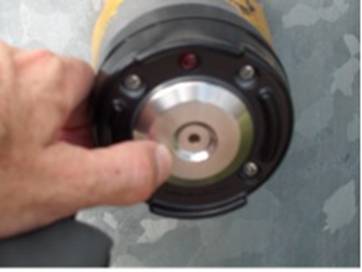
Figure 3.1 Picture of Pedestrian Push Button That Confirms Press
Notes: It was difficult to see the LED light in bright Florida sunlight. It appeared that the auditory feedback was more critical to the efficacy of the device. In areas with less bright sunlight the pilot light might be more salient. These buttons might also be of useful to visually impaired pedestrians because they confirm the button press. However, accessible call buttons with a locator tone would be preferred when taking into account the needs of visually impaired pedestrians.
| Location | Installation | Qty | Corridor |
|---|---|---|---|
| Alton Rd. & 15th St. | East–West Crosswalks | 4 | 1 |
| Alton Rd. & 16th St. | East–West Crosswalks | 4 | 1 |
| Alton Rd. & 17th St. | East–West South leg only | 2 | 1 |
| Alton Rd. & 6th St. | East–West Crosswalks | 4 | 1 |
| Alton Rd. & 8th St. | East–West Crosswalks | 4 | 1 |
| 5th St. & Collins Ave. | North–South on East leg only | 2 | 2 |
| 5th St. & Merridan Ave. | North–South Crosswalks | 4 | 2 |
| 41st St. & Chase Ave. | North–South Crosswalks | 4 | 7 |
| 41st St. & Royal Palm Ave. | North–South Crosswalks | 4 | 7 |
| 41st St. & Pine Tree Drive | North–South Crosswalks | 4 | 7 |
| NE 163rd St. & 8th Ave. | North–South Crosswalks | 4 | 10 |
| NE 163rd St. & 12th Ave. | North–South Crosswalks | 4 | 10 |
| 900 N. Miami Beach Blvd. | 2 Midblock Crosswalks | 4 | 10 |
| NE 163rd St. & 15th Ave. | North–South Crosswalks | 4 | 10 |
| NE 163rd St. & 19th Ave. | North–South Crosswalks | 4 | 10 |
| NE 6th Ave. & 167th St. | East–West Crosswalks | 4 | 11 |
| NE 6th Ave. & 149th St. | East–West Crosswalks | 4 | 11 |
| 64 | |||
This pedestrian safety measure had federal approval status according to the Manual on Uniform Traffic Control Devices (MUTCD) when they were purchased.
The cost for each pedestrian push button was $105.00. The installation cost was $40.00 per call button for a total cost of $145.00 per installed button.
This product can be purchased off the shelf.
This device was installed by changing out existing push buttons that did not provide feedback when pressed. The project contractor installed this countermeasure.
None
This device was easy to install. There were no challenges.
These devices seem reliable and durable and are associated with minimal maintenance needs. Because these push buttons provide feedback when they are pressed we observed fewer multiple presses, which could extend the life of the buttons, reducing maintenance costs over conventional buttons.
This treatment was installed at mid-block traffic signals. It required the signal to be operated in isolation mode (non synchronous timing). The minimum green time was reduced to decrease pedestrian wait time and increase compliance with the signal. Three of these treatments were installed as indicated in table nine. Prior to the start of the study both signals were run in synchronous mode, and the cycle length was 130 s between 8 am and 8 pm at the Alton Road crosswalk and varied from 90 s to 120 s at the crosswalk on SW 8th Street. Minimum green time was evaluated at 30 s, 1 minute and 2 minutes at both crosswalks. The speed limits at these locations were 35 mph on Alton Rd. and 30 mph on SW 8th St.
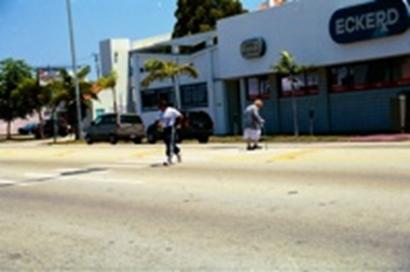
Figure 3.2 Picture of Midblock Crossing with Reduced Minimum Green Time
| Location | Installation | Qty | Corridor |
|---|---|---|---|
| Alton Midblock between 14th St. and 14th Court | Minimum green time was reduced to 1 minute. | 1 | 1 |
| Midblock at 1300 8th | Minimum green time was reduced to 1 minute. | 2 | outside zones |
| Midblock Crosswalk at Barrt College | Minimum green time was reduced to 30 s. | 2 | outside zones |
| NE 5th St. of NE 1st Ave.* | North and South side of crosswalk | 1 | outside zones |
| 6 | |||
* Note that city installed midblock crosswalk at this site
Notes: This treatment markedly improved pedestrian compliance, and greatly reduced pedestrian wait time; however, switching from synchronous to isolated mode with a short minimum green time increased motorist delay. Therefore this treatment would be most likely to be installed in communities that value pedestrian flow or at sites where the trade-off between pedestrian delay and safety balanced the increase in vehicle delay.
The signal timing changes made to deploy this treatment were in compliance with the MUTCD.
There are no hard costs associated with the deployment of this countermeasure. However, the installation of this countermeasure at NE 5th St. East of NE 1st Ave. includes the cost of installing the midblock signal.
This only requires signal-timing changes. It is relatively easier to deploy if it can be done on a central traffic signal computer rather than making the changes at the signal cabinet.
The Miami-Dade signals engineer and his staff deployed this countermeasure.
None
This countermeasure was easy to deploy. There were no challenges.
There are no maintenance requirements associated with this countermeasure.
This device uses video detection technology to detect the pedestrian and put in a call for a mid-block traffic signal. An Autoscope Solo Pro was used for pedestrian detection in this study. The processor was included in the camera. The camera sent compressed video via twisted pair. Two rectangular zones were set up on the sidewalk approaching the curb; the pedestrian had to cross both zones to trigger the device. The device could determine direction of movement by the order in which the zones were crossed. With this method the pedestrian only put in a call when entering the crosswalk. This system was installed at one midblock traffic signal on Alton Road.
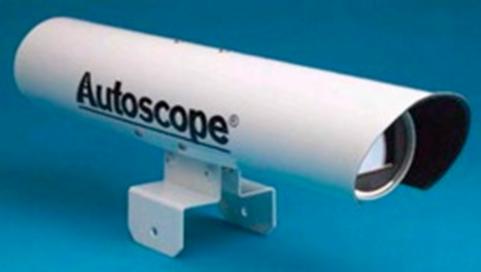
Figure 3.3 – Picture of Device Used For Pedestrian Detection
| Location | Installation | Qty | Corridor |
|---|---|---|---|
| Alton Midblock Crosswalk between 14th St. and 14 Court | East Side | 1 | 1 |
| Alton Midblock Crosswalk between 14th St. and 14 Court | West Side | 1 | 1 |
| 2 | |||
Notes: This device was reasonably reliable in detecting pedestrians but it did not detect joggers that ran into the intersection and cyclists that rode into the intersection. It did not put in false calls.
This pedestrian safety measure does not require special approval.
The cost for the complete video detection system was $14,250. The installation cost was $6252. to install the complete system.
This product can be purchased off the shelf.
Our contractor mounted this device on the mast arm pole. The manufacture assisted us in defining the departure rectangles and ensuring that the device worked correctly.
None
It would have been more difficult to install the device without the assistance of the manufacturer.
They are unknown; however, it is likely that these devices should prove as reliable at similar devices currently used to detect vehicles.
The purpose of this device was to give a head start for pedestrians over left and right turning vehicles at the start of the WALK. Pedestrians crossing the main line receive a 4 second exclusive pedestrian phase while all vehicle signals remained in the all red phase. These vehicles lost 4 seconds of green time in order to give the pedestrians a 4 second exclusive pedestrian phase. This treatment provides the best protection from vehicles turning left and provides less protection from vehicles turning right because they may still turn right on red.
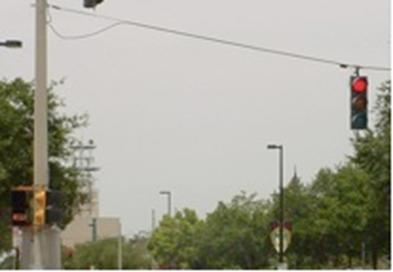
Figure 3.4 – Picture of Leading Pedestrian Phase
Notes: This treatment was effective at increasing yielding by drivers turning left but was not effective at improving the behavior of drivers turning right. Prohibiting right turn on red at the start of the WALK when a pedestrian pushed the call button should greatly improve the efficacy of this countermeasure.
| Location | Installation | Qty | Corridor |
|---|---|---|---|
| Alton Rd. & 16th St. | Applied to intersection phasing. North & South legs | 1 | 1 |
| Alton Rd. & 6th St. | Applied to intersection phasing. North & South legs | 1 | 1 |
| Alton Rd. & 8th St. | Applied to intersection phasing. North & South legs | 1 | 1 |
| Collins Ave. & 15th St. | Applied to intersection phasing. North & South legs | 1 | 5 |
| Collins Ave. & Lincoln Rd. | Applied to intersection phasing. North & South legs | 1 | 5 |
| 5 | |||
The signal timing changes made to deploy this treatment were in compliance with the MUTCD.
There were no hard costs associated with the deployment of this countermeasure.
This treatment only requires signal-timing changes. It is relatively easier to deploy if it can be done on a central traffic signal computer rather than making the changes at the signal cabinet.
The Miami-Dade signals engineer and his staff deployed this countermeasure.
None
This countermeasure was easy to deploy. There were no challenges.
There are no maintenance requirements associated with this countermeasure.
This treatment was a symbol version of the “Turning vehicles must yield to pedestrians” text sign. This sign retained the text message “Turning vehicles” and “to” and substituted the yield symbol for the word “yield” and the pedestrian symbol for the word “pedestrian”. The purpose of using this sign in place of the text message sign was to make the sign more comprehensible to tourists that were not native speakers of English and to increase recognition distance.
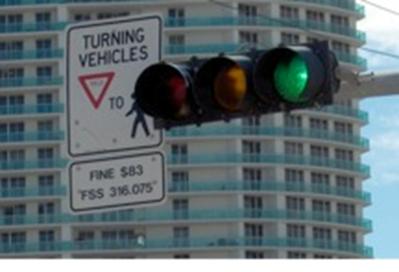
Figure 3.5 Picture of “Turning Vehicles Yield to Pedestrians” Symbol Sign
| Location | Installation | Qty | Corridor |
|---|---|---|---|
| Alton Rd. & 16th St. | Facing minor street, E & W approaches | 2 | 1 |
| 5th St. & Collins Ave. | All approaches | 4 | 2 |
| 5th St. & Jefferson Ave. | Facing minor street, N & S approaches | 2 | 2 |
| 5th St. & Meridian Ave. | All approaches | 4 | 2 |
| 5th St. & Michigan Ave. | Facing minor street, N & S approaches | 2 | 2 |
| 5th St. & Washington Ave. | All approaches | 4 | 2 |
| Collins Ave. & 11th St. | Facing minor street, E & W approaches | 2 | 5 |
| Collins Ave. & 14th St. | Facing minor street, E & W approaches | 2 | 5 |
| Collins Ave. & 16th St. | All approaches | 3 | 5 |
| Collins Ave. & 17th St. | W & N approaches only | 2 | 5 |
| Collins Ave. & 21st St. | All approaches | 4 | 5 |
| Collins Ave. & 41st St | W & N approaches only | 2 | 6 |
| Indian Creek & 41st St. | Facing minor street, E & W approaches | 2 | 6 |
| Collins Ave. & 75th St. | On N & W approaches | 2 | 8 |
| Harding Ave. & 75th St. | North-South on East leg only | 2 | 8 |
| Indian Creek & 65th St. | On E & S approaches | 2 | 8 |
| Normandy Dr. & Bay Dr. | On N & S approaches | 2 | 8 |
| NE 163rd St. & 19th Ave. | On S & W approaches | 2 | 10 |
| NE 167th St, & NE 8th Ave. | All approaches | 4 | 10 |
| 49 | |||
This treatment was effective at increasing yielding at one site but ineffective at the other site.
This sign was tested under FHWA permission to experiment.
The cost for each sign was $25.00. The installation cost was $55.00 per sign for a total cost of $80.00 per installed sign.
Any sign shop can prepare this sign.
Our contractor mounted this device on the mast arm pole.
None
There were no installation challenges involved in installing these signs. However deployment did require traffic control and the use of a truck with a mechanical arm to install the device on the mast arm.
There are no maintenance requirements associated with this countermeasure.
This sign was illuminated when right turn on red was not permitted. The sign was installed on the mast arm in the same location that the static “No turn on red when pedestrians in crosswalk” sign and the “No turn on red” sign were installed. This allowed a direct comparison of all three signs.
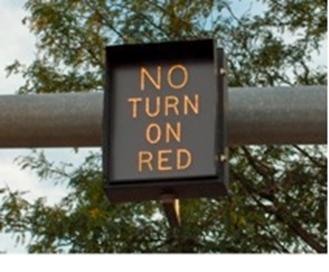
Figure 3.6 Picture of Electronic No Turn on Red Sign
Notes: The electronic NRTOR sign reduced the percentage of motorists turning right-on-red when a pedestrian was present over that produced by the two static signs and reduced the percentage of conflicts between vehicles turning right on red and pedestrians crossing within the crosswalk over the other two signs. However there were many violators during all conditions. The electronic sign had an even larger effect on increasing the percentage of violators coming to a complete stop before turning right-on-red and almost eliminated free flow right-on-red turns that are most dangerous to pedestrians.
| Location | Installation | Qty | Corridor |
|---|---|---|---|
| 41st St. & Pine Tree Dr. | Facing North bound traffic | 1 | 7 |
| 1 | |||
The cost for this sign was $3000.
These signs are available off the shelf. They need to be installed with a utility truck with an arm and bucket. These signs also have to be wired into the controller system.
Miami-Dade County installed this sign on the mast arm pole.
None
There were no installation challenges involved in deploying this sign. However deployment did require traffic control and the use of a truck with a mechanical arm to install the device on the mast arm.
There were no maintenance requirements associated with this countermeasure. However this sign will eventually need to be replaced or serviced after the service life of the lights has expired.
This treatment was a countdown pedestrian signal that displayed a walking person symbol during the "WALK" indication, counted down the seconds in the clearance phase along with the flashing hand display, and displayed the solid hand during The "DON’T WALK" indication which began during the all red phase. These signals were programmed to begin the countdown at the start of the pedestrian clearance (flashing hand) phase and counted down to 0 at the end of the yellow phase.
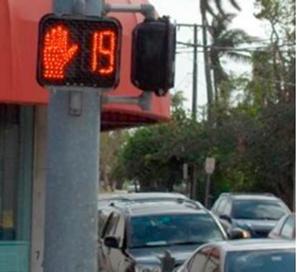
Figure 3.7 Picture of a Pedestrian Countdown Signal
Notes: The countdown displays decreased the percentage of pedestrian in the crosswalk during the all red phase and were associated with an increase in the percentage of pedestrians that pressed the call button as well as the percentage of pedestrians that pressed the call button that then waited for the WALK indication.
This pedestrian safety measure has federal approval status according to the Manual on Uniform Traffic Control Devices (MUTCD).
The cost for each call button was $495.00. The installation cost was $45.00 per call button for a total cost of $540.00 per installed button.
This product can be purchased off the shelf.
This device was installed by changing out existing incandescent pedestrian signals that did not provide a countdown feature. The project contractor installed these devices.
None
| Location | Installation | Qty | Corridor |
|---|---|---|---|
| Alton Rd. & 8th St. | North & South legs | 4 | 1 |
| Alton Rd. & 15th St. | All legs | 8 | 1 |
| Alton Rd. & Lincoln Rd. | All legs | 8 | 1 |
| Alton Rd. & 16th St. | All legs | 8 | 1 |
| Alton Rd. & 17th St. | East, West & South legs | 6 | 1 |
| 41st. St. & Alton Rd. | All directions | 8 | 7 |
| 41st. St. & Chase Ave. | South, East & West legs | 6 | 7 |
| 41st. St. & Royal Palm Ave. | All directions | 8 | 7 |
| 163rd St. & 12th Ave. | East & West legs | 4 | 10 |
| 163rd St. & 15th Ave. | All legs | 8 | 10 |
| 163rd St & 18th Ave. | all legs | 8 | 10 |
| 163rd St. & 19th Ave. | East & West legs | 4 | 10 |
| 163rd St. & West Dixie Hwy | East & West legs | 4 | 10 |
| NE 167th St. & NE 2nd Ave. | East & West legs | 4 | 10 |
| NE 167th St. & NE 6th Ave. | All legs | 8 | 10 |
| NE 6th Ave & NE 145th St. | North & South legs | 4 | 11 |
| NE 6th Ave & NE 149th St. | North & South legs | 4 | 11 |
| 104 | |||
These devices were easy to install. There were no challenges.
These devices seem reliable and durable and are associated with minimal maintenance needs. They will eventually be replaced at the end of the LEDs lifetime.
In-Street Pedestrian Signs are intended for use at uncontrolled (not signalized) crosswalks to remind drivers of laws regarding pedestrians’ right-of-way. They are more noticeable than roadside signs and may also exert a minor traffic-calming effect by effectively narrowing the inside lanes slightly. Dimensions and color: 12” x 44”, fluorescent yellow green diamond sheeting with 10” x 24” white high intensity sheeting inserts. Overall height is 47 inches. The signs can be installed with either a portable or fixed base.
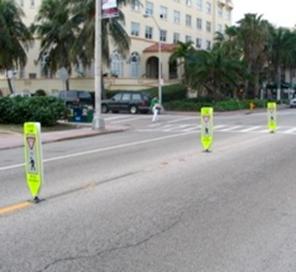
Figure 3.8 Picture of In-street “Yield to Pedestrians” Signs
Notes: These signs were effective but had a very short lifespan. The streets were narrow and did not have a median island to protect the signs. We found that using three signs on each approach was no more effective than using one.
| Location | Installation | Qty | Corridor |
|---|---|---|---|
| Collins Ave. @ 6th St. | These signs were placed facing North and South approaches | 2 | 5 |
| Collins Ave. @ 9th St. | These signs were be placed facing North and South approaches | 2 | 5 |
| Collins Ave. @ NE 13th St. | These signs were be placed facing North and South approaches | 2 | 5 |
| 6 | |||
This pedestrian safety measure has federal approval status according to the Manual on Uniform Traffic Control Devices (MUTCD) Section 2B.12, IN STREET PEDESTRIAN CROSSING SIGN (R1-6, R16a). The legend “State Law” may be shown at the top of the sign if applicable. The legends “Stop For” or “Yield To” may be used in conjunction with the appropriate symbol. If a median island is available, the in-street pedestrian crossing sign, if used, should be placed on the island.
The cost for each sign was $225.00. The installation cost was $50.00 per sign for a total cost of $275.00 per installed sign.
This product can be purchased off the shelf.
Our contractor installed these devices.
These signs were not durable enough to use on narrow roads with many large trucks making turning movements.
The primary challenge was maintaining the signs.
The maintenance cost for these signs was excessive. The rectangular rapid flash beacon may be a more durable installation at these locations.
MUTCD R1-6 signs may be used along with a plaque indicating the distance that pedestrians may be expected.
| Location | Installation | Qty | Corridor |
|---|---|---|---|
| Collins Ave. @ 75th St. | Pedestrian Crossing warning signs installed 30 ft North of Northernmost crosswalk facing Northbound traffic | 1 | 8 |
| Harding Ave. @ 75th St. | Pedestrian Crossing warning signs installed 30 ft South of Southernmost crosswalk facing Southbound traffic | 1 | 8 |
| NE 6th Ave. @ NE 141st St. | Pedestrian Crossing warning signs installed 30 ft North of Northernmost crosswalk facing Northbound traffic and 30 ft South of Southernmost crosswalk facing Southbound traffic | 2 | 11 |
| NE 6th Ave. @ NE 142nd Ave. | Pedestrian Crossing warning signs installed 30 ft North of Northernmost crosswalk facing Northbound traffic and 30 ft South of Southernmost crosswalk facing Southbound traffic | 2 | 11 |
| NE 6th Ave. @ NE 145th St. | Pedestrian Crossing warning signs installed 30 ft North of Northernmost crosswalk facing Northbound traffic and 30 ft South of Southernmost crosswalk facing Southbound traffic | 2 | 11 |
| NE 6th Ave. @ NE 149th St. | Pedestrian Crossing warning signs installed 30 ft South of crosswalk facing Southbound traffic | 1 | 11 |
| Collins Ave. & 16th St. | Pedestrian Crossing warning signs installed 30 ft South of crosswalk facing Southbound traffic | 1 | 5 |
| Collins Ave. & 14th St. | Pedestrian Crossing warning signs installed 30 ft South of Southernmost crosswalk facing Southbound traffic | 1 | 5 |
| 11 | |||
Notes: These signs had no effect on driver speed. It is unclear whether they contributed to the reduced level of crashes observed in this study.
This pedestrian safety measure has federal approval status according to the Manual on Uniform Traffic Control Devices (MUTCD).
The cost for each sign was $25. The installation cost was $45. per sign for a total cost of $70. per installed sign.
This product can be purchased off the shelf.
Our contractor installed these devices.
There were no issues.
There were no installation challenges.
Signs are durable with a long lifetime unless struck by a vehicle.
Portable Changeable Message Speed Limit Signs, also known as “radar speed trailers,” are used to deter speeding. These devices can be installed along the side of the road; typically in parking areas, and display the speed of each approaching vehicle and can flash LEDs when the approaching vehicle is speeding. A speed limit sign is included on the trailer. Above a user-selected maximum, the sign “blanks out” to avoid enticing drivers into exhibitions of speed. A computer within the device recorded speed data.
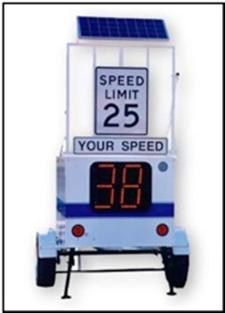
Figure 3.9 Picture of a Speed Trailer
| Location | Installation | Qty | Corridor |
|---|---|---|---|
| Collins Ave. @ 32nd St. | ITS Speed Trailer placed midblock before intersection |
1 | 6 |
| Collins Ave. @ 36th St. | ITS Speed Trailer placed midblock before intersection |
1 | 6 |
| Collins Ave. @ 72nd St. | ITS Speed Trailer placed midblock before intersection |
1 | 8 |
| 3 | |||
Notes: These signs reduced braking for pedestrians but had little effect on vehicle speed. One reason why the sign was ineffective in reducing vehicle speed was most vehicles were already driving within the speed limit.
Changeable speed limit signs are approved in MUTCD Section 2B.13, Speed Limit Sign (R2-1): “A changeable message sign that displays to approaching drivers the speed at which they are traveling may be installed in conjunction with a Speed Limit sign.” According to MUTCD guidelines “If a changeable message sign displaying approach speeds is installed, the legend YOUR SPEED XX km/h (MPH) or such similar legend should be shown. The color of the changeable message legend should be a yellow legend on a black background or the reverse of these colors.”
For signs typically used on roadways with 45 MPH & greater speed limits the MUTCD specifies sign dimensions of 36 by 48 inch (18 inch high digits).
For neighborhoods and school zones, the MUTCD specifies that the absolute minimum sign size allowed is 24 x 30 inches (12" high digits), and it provides for larger dimensions in increments of six inches "where speed, volume, or other factors result in conditions where increased emphasis, improved recognition, or increased legibility would be desirable" [2003 MUTCD 2B.03].
The speed trailers were furnished by the City of Miami Beach.
The estimated cost for each trailer was $25 per day. The estimated installation cost was $45 per trailer.
This product can be purchased off the shelf.
Speed trailers were loaned to the project by the City of Miami Beach.
No significant issues.
Speed trailers are common equipment items with municipal and law enforcement organizations.
The primary maintenance issue was moving the signs. There is sufficient sunlight in Miami to ensure the signs remained charged.
This treatment was the standard pedestrian warning sign with two LED flashers attached (see Figure 1). The LED flashers were each 6 inches wide and 2.5 inches high placed 9 inches apart. Each unit was dual indicated (LED's on front and back). Each side of the LED beacon flashed in a wig-wag flashing sequence (left, then right) the 2 large LED's in combination flashed 76 times in the wig-wag flashing sequence during a 30 second cycle. Of the 2 large LED's, the Left LED, flashed 2 times (in a slower type of a rapid flash) each time it was energized followed by the Right LED, which flashed in a very fast rapid 3 flash volley when energized. The total number of flashes in this combination was 190 total flashes per 30 second cycle. Four signs along with beacons were installed at each crosswalk. The devices were linked by radio frequency transponders so a depression of any of the pedestrian call buttons immediately activated the flashers on all four signs. At the South Bayshore Drive crosswalk a sign was placed on the left side of each approach and on the right side of each approach at the median island. At the NW 67th Street site a sign along with beacons was placed on the left side of each approach and on the right side at a median just after the crosswalk on the northbound approach and before the crosswalk on the southbound approach. A LED facing the pedestrian flashed to indicate to pedestrians that the system was operating. The system also presented an audible message instructing pedestrians that the light flashing across the street indicates that the device was operating, and instructing them to wait for cars to stop before crossing. Signal duration was timed assuming a crossing speed of 3.5 feet per second.
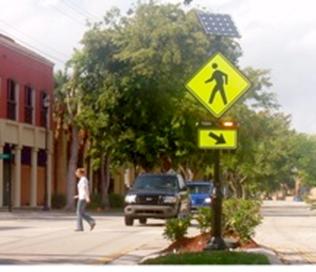
Figure 3.10 Picture of Rectangular LED Rapid Flashing Beacons
| Location | Installation | Qty | Corridor |
|---|---|---|---|
| NW 67th St. @ Main Street | North and South Approaches on roadside and on median |
4 | Outside zones |
| South Bayshore Drive @ Darwin | North and South Approaches on roadside and on median |
4 | Outside zones |
| S.W. Avenue @ S.W. 163rd St.. | Both Approaches | 2 | Outside zones |
| Ponce De Leon @ Soaraz Ave. | Both Approaches | 2 | Outside zones |
| 12 | |||
Notes: These signs produced large increases in the percentage of motorists yielding to pedestrians on multilane roads.
This device was installed in accordance with permission to experiment granted by FHWA to FDOT.
The cost for each sign installed sign unit was $15,000. The installation cost was included with the sign cost. The overall cost was $150,000.00 for these units. The cost was higher for the Miami-Dade units because they required ornamental units that conformed with the surroundings.
This product can be purchased off the shelf.
The vendor installed these devices. Because the vendor installed these devices, there were no installation issues.
No significant issues.
Because the device relies upon radio frequency communication to link the devices, there is no need to install wiring under the roadway. Because the device is solar powered there is no need to connect power to the unit.
These devices seem very reliable. The primary maintenance issue would be the repair or replacement of a unit if a vehicle strikes it.
This treatment was used in conjunction with the rectangular LED rapid flashing beacons treatment described above. When a pedestrian pressed the call button to activate the beacon at night, the device was activated and LED white lighting illuminated the departure portion of the curb face and the first 4 feet of the crosswalk. This dynamic pad lighting consisted of four 2.5 by 1.25 inch housings each containing 3 LEDs.

Figure 3.11 Picture of Dynamic Lighting
| Location | Installation | Qty | Corridor |
|---|---|---|---|
| NW 67th St. @ Main Street | North and South Approaches on roadside and on median |
4 | Outside zones |
| South Bayshore Drive @ Darwin | North and South Approaches on roadside and on median |
4 | Outside zones |
| S.W. Avenue @ S.W. 163rd St.. | Both Approaches | 2 | Outside zones |
| Ponce De Leon @ Soaraz Ave. | Both Approaches | 2 | Outside zones |
| 12 | |||
Notes: The LED lighting was not very bright compared with the rectangular rapid flashing beacon. There activation did not increase yielding above the level obtained with the beacons system alone.
The cost for the lighting feature was included in the price of the beacons. A switch was installed to allow researchers to turn the lighting feature on and off to evaluate its efficacy.
These signs are available off the shelf. However, they do require permission to experiment at this time.
The vendor installed this device.
None were noted.
Because geometric features influence the location of the beacon system, in some cases the lighting did not fully illuminate the departure area of the crosswalk.
There were no maintenance requirements associated with this countermeasure. However, the unit will eventually need to be replaced after the service life of the unit has expired.
This treatment involved reconfiguring the signal heads to eliminate permissive left turns.
Notes: This treatment reduced conflicts between pedestrians and left turning vehicles. However many drivers violated the red immediately following the end of the protected left turn phase. It may be better to use a lagging left turn phase with this treatment.
| Location | Installation | Qty | Corridor |
|---|---|---|---|
| 41st St. & Pine Tree | East and West Direction | 2 | 7 |
| 2 | |||
The cost for the signal change was $4,000.
The hardware needed to make this change is readily available.
Miami-Dade County made the changes to the signal head and made the signal phase changes.
None
There were no installation challenges involved in making this change.
This change does not have a significant impact on maintenance of the traffic signal.
This treatment involved installing stop bars 20 feet in advance of the crosswalk rather than the minimum distance of 4 feet in advance of the crosswalk. Studies have shown that offset and setback stop bars can reduce vehicle/pedestrian conflicts. Setting back stop bars has also been shown to add .75 s to intersection clearance time and can reduce turning vehicle threats by increasing intersection visibility.
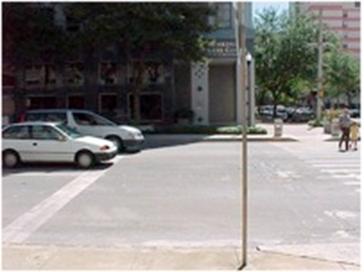
Figure 3.12 Picture of Offset Yield Lines
Notes: This treatment is easier to install on fresh pavement.
| Location | Installation | Qty | Corridor |
|---|---|---|---|
| 167th St. & 2nd Ave. | All approaches to intersection | 4 | 10 |
| 168th St. & 6th Ave. | All approaches to intersection | 4 | 10 |
| 169th St. & 8th Ave. | All approaches to intersection | 4 | 10 |
| 170th St. & 12th Ave | All approaches to intersection | 4 | 10 |
| 171st. St. & 15th Ave | All approaches to intersection | 4 | 10 |
| 172nd St. & 16th Ave. | All approaches to intersection | 4 | 10 |
| 173rd St. & 17th Ave | All approaches to intersection | 4 | 10 |
| 174th St. & 19th Ave. | All approaches to intersection | 4 | 10 |
| 175th St. & W. Dixie Highway | All approaches to intersection | 4 | 10 |
| 36 | |||
The cost to put down thermoplastic lines was $200.
This item is readily available
Florida Department of Transportation installed the advance stop lines.
None
There were no installation challenges involved in deploying this counter measure.
Moving the stop bar has do significant impact on maintenance of the markings.
Advance yielding markings may be installed in advance of crosswalks at uncontrolled locations. Previous work has shown that advance yield markings placed 30 feet in advance of the crosswalk increases the distance that drivers yield in advance of the crosswalk. Advance yield markings were only installed at one site because the sign size specified in the 2003 manual was much smaller than the sign used in the research that supported the introduction of this marking into the manual.
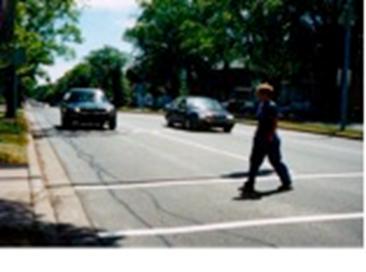
Figure 3.13 Picture of Advance Yield Markings
Notes: This treatment is designed to reduce multiple threat conflicts and therefore has been installed at the two multilane locations with the rectangular LED rapid flash beacon.
| Location | Installation | Qty | Corridor |
|---|---|---|---|
| 41st St. & Pine Tree | East and West Direction | 2 | 7 |
| 2 | |||
The cost for installing these markings was $200 each.
This item is available off the shelf.
Markings were installed by our Contractor on Collins @ 7th and by Miami-Dade County at the Miami Lakes and Coconut Grove rectangular LED rapid flash beacon sites.
None
It was not possible to get approval for the correct sign size. This issue will be resolved in the next version of the MUTCD.
This marking does not have a significant impact on maintenance costs.
| < Previous | Table of Content | Next > |
